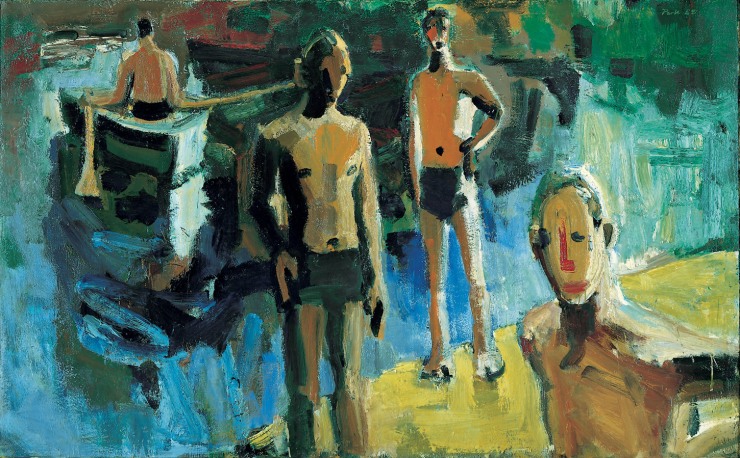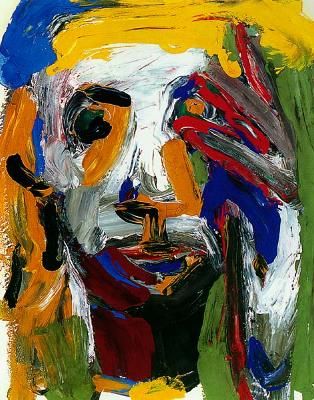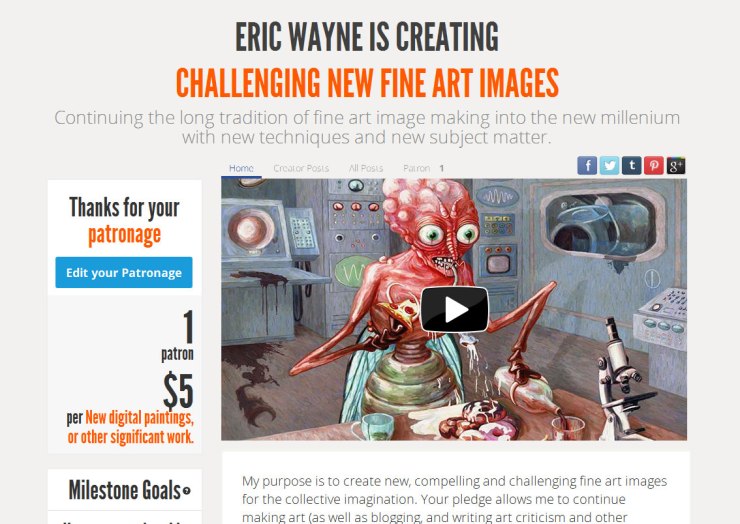
I’ve known about David Park for a long time, but only today did I realize that he wasn’t a contemporary artist. I discovered him around the time that Neo-Expressionism was in full force, and I just thought he was a living Bay Area Neo-Expressionist. I guess I didn’t read the captions carefully on any of his art, which I saw in magazines. Nobody every taught us about David Park in my art schools. It gets worse. I believe I thought he was Korean, er, because of his name. I saw his work as a little safe as compared to Neo-Expressionists who I believed were his contemporaries, such as Eric Fischl and Francesco Clemente. But today I looked him up. I couldn’t remember his name, so Googled “Bay Area Figurative Painters”. And then in his Wikipedia entry I was startled to learn he died of cancer in 1959, before I was born. I was thinking of trying to contact him! He also died when he was precisely my age = 49 (not that I attach any significance to such things, except it’s a reminder that someone’s career ended when I’m trying to get mine off the ground).

In the picture up top, his use of reds is phenomenal, especially in the way he uses it not only as a curious and bold choice for the background, but also as light coming through one person’s ears, and as a reflection on the others nose and lip. I consider him an artist’s artist. I can get into every stroke of paint, and luxuriate in the blue greens in the hair. He has the power of some of the best of Emile Nolde, but from a 50’s American vantage, and his work is so much better when I realize it wasn’t done in the 80’s as I’d thought. Now I remember I’d even associated his name with it’s meaning, parks, and kinda’ thought of him making pleasant day-in-the-park sorts of simple figures. Nothing to get excited about, please move along to the real shit.

As it happens, not many were interested in his work during his lifetime. As usual, people thronged to whatever the fad and fanfare were about, which was Abstract Expressionism and Pop Art. Despite the obvious beauty of his canvases for people who like paint, he was going against the grain, and probably seemed a marginal artist who couldn’t quite grasp the audacity of what the New York Abstract Expressionists were doing.

Given the romance and supremacy accorded to Abstract Expressionism, it would be hard to take a figurative artist seriously at the time, not when people think in terms of art being a linear progression, something like scientific discovery, in which case figuration of this sort would be assumed to be a relic of a bygone era.
Park had criticized the abstract painters:
“I believe that we are living at a time that overemphasizes the need of newness, of furthering concepts”.
Yeah, that’s a bigger problem now than then. But the significance of it is that if he wasn’t trying to position himself as “furthering concepts”, than he wasn’t going to get recognition as a serious contributor, since people increasingly value ideas about art over art itself (which is like valuing ideas about food over eating).

But it’s not that clear if he was hopelessly behind, far ahead, or what I think, just doing something different. He’d been an abstract painter but decided to go figurative. He took his assembled abstract paintings to the town dump. I call that conviction. I still have most of my old crap, even from when I was a kid.
He had this to say about his transition:
“As you grow older, it dawns on you that you are yourself – that your job is not to force yourself into a style but to do what you want. I saw that if I would accept subjects, I could paint with more absorption, with a certain enthusiasm for the subject which would allow some of the esthetic qualities such as color and composition to evolve more naturally.”
It’s a good point: not to do what you think you are supposed to, but what you really want to. And since I’ve thought for decades that his paintings were from the 80’s, and hence came along long after the official demise of Abstract Expressionism (I think it’s here to stay), maybe some aspects of his art were forward looking.
His late ones are the best, and they appear fresh because of their deceptive forthrightness, and the economy of strokes. A whole head looks like it was accomplished in a dozen broad strokes, even if they were worked and reworked. That’s what I remember from when I first discovered him, how he’d achieve a human presence with a minimum of visible brush strokes; how an upside down question mark could be a forehead, nose, and then wrap around the mouth and make the chin. Eyes are single dabs. Of course these strokes are layers and there are smaller, less conspicuous strokes that add variety and detail, as well as artifacts such as drips or texture from a dabbed brush that was then pulled back.

In “Four Boats”, above, he somehow captures a whole scene using barely more than stick figures. This has to do with combining sophisticated color, lighting, shading and modeling with very simple subjects. The man in front has an “L” for a nose, dots for eyes, and a dash for a mouth, but his skin is a wide range of browns, greens, and yellows. His head casts a shadow on his chest, and the boat has a mirror reflection broken by ripples in the water. Park worked from memory and imagination rather than models, and the result is a dreamscape, but of everyday activities.

I painted things like an alien autopsy, a robot battling a monster, and a human fly from my imagination – y’know, things that you can’t look at and copy – but Park used his imagination to make a woman pouring coffee.

A green headed woman! And yet she seems to have poise and dignity. And this brings me back to the Expressionist thing. What is wrong with Expressionism? Park is considered a “Bay Area Figurative Artist”, but the movement sounds so regional, kind of like “California Plein Air Painters”. As if there’s a different group of similar painters in each geographic region, or it’s more important that there’s a loose group of these artists who happen to be from the Bay Area. But it’s straight up Expressionism, and it’s really not the same thing as what Diebenkorn was doing. Park’s work has as much in common with Georges Rouault, in its luminosity, and Emile Nolde in its use of bold color and large strokes.

Park manages to achieve radiance in his canvases, much like the Rouault above, but doesn’t use Rouault’s thick black outlines, or outlines at all. He uses color contrast to delineate form. Note that Rouault died just a year before Park, in 1958, but was about 87 years old. He may have seen Park’s works, but only at the very end. Park also reminds me of Emile Nolde with his use of bold colors and broad strokes to define faces.


Articles about Park always designate him a figurative painter, but not an Expressionist, whereas I find his work clearly Expressionistic, even over-the-top Expressionistic. Look at this one:
 It’s almost too Expressionist for my tastes. I suppose “Bay Area Figurative Artist” at least sounds distinctly American, and if we were to call him an Expressionist he’d be linked back with older movements and he’d seem even less about “furthering concepts”. How about this next one? It certainly is moody with its red buildings.
It’s almost too Expressionist for my tastes. I suppose “Bay Area Figurative Artist” at least sounds distinctly American, and if we were to call him an Expressionist he’d be linked back with older movements and he’d seem even less about “furthering concepts”. How about this next one? It certainly is moody with its red buildings.

Or say this one?

If that isn’t Expressionism, I don’t know what is.
However we classify him isn’t really important. I enjoy his paintings irrespective of any “ism” or where he’s positioned in the narrative of art history, or whatever worth the art world attributes to his work. I don’t like art because I think it’s important. I like it because I like to look at it, and Park made some really good pictures.
I leave you with a gallery of more of his paintings that I like. I’m sure I’d really enjoy a retrospective.
~ Ends
And if you like my art and art criticism, and would like to see me keep working, please consider making a very small donation. Through Patreon, you can give $1 (or more) per significant new work I produce, and cap it at a maximum of $1 a month. Ah, if only I could amass a few hundred dollars per month this way, I could focus entirely on my art. See how it works here.
Or go directly to my account.
Or you can make a small, one time donation to help me keep on making art and blogging (and restore my faith in humanity simultaneously).























Great post. I enjoy learning about new artists and since you have such a crazy extensive knowledge of them, I like these kinds of posts from you. Cheers.
LikeLike
it’s “four men” 1958, not “four boats”
LikeLike
So it is.
LikeLike
Just seen this. I knew little about David Park beyond his name and a few small illustrations but now much more. I agree with your sentiment that you ‘don’t like art because I think it’s important. I like it because I like to look at it, …’ After fifty odd years of looking that is where I have ended up. I would certainly like a retrospective of Park’s work and wonder why no one has organised one. Park is one of a group of artists who worked before the ‘art world’ and ‘gallerists’ came along – it shows and it is why his work is so sincere.
LikeLiked by 1 person
Hi Barry. Glad you liked the article. Of course I agree about Park. There are a dozen or so canvases that I’m crazy about. Also, the contemporary art world had been rather strongly anti-figurative painting for about a half century. One way to think about this is something my art teachers used to say to me when I attempted to do figurative work, “it’s as if the last 100 years of development in art didn’t happen”. That’s how they see it.
There’s a very strong conviction that conceptual art evolved out of painting and rendered it redundant. This is a false belief, and I tackle it mercilessly in multiple posts. But I should do so again in a short, pithy post that explains why painting and conceptual art are two entirely different, and unrelated genres, with about as much in common as music and architecture.
The problem is that painting is now lumped together with conceptual art under the banner of conceptual art, in which case painting is judged by the standards of conceptual art. This is why painting always loses. But, as I will point out sometime soon when I’m in a mood to rant, you can only compare paintings (more loosely visual art) with other paintings, not with performance art, sound sculpture, video, installations, or earthworks…
Thanks for reading and commenting.
LikeLike